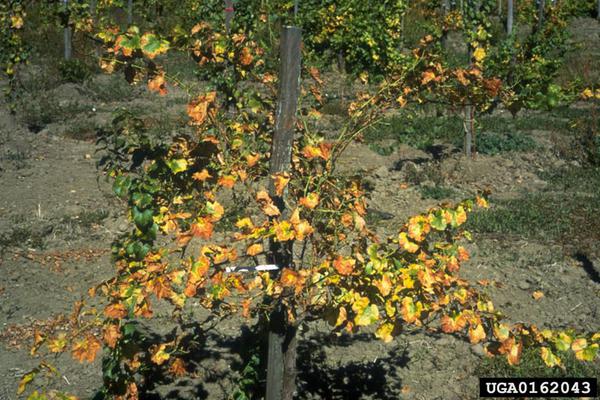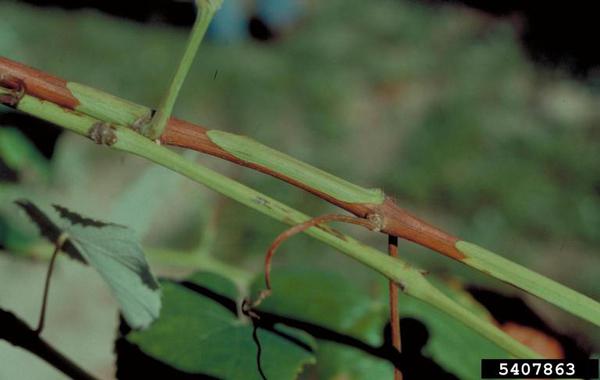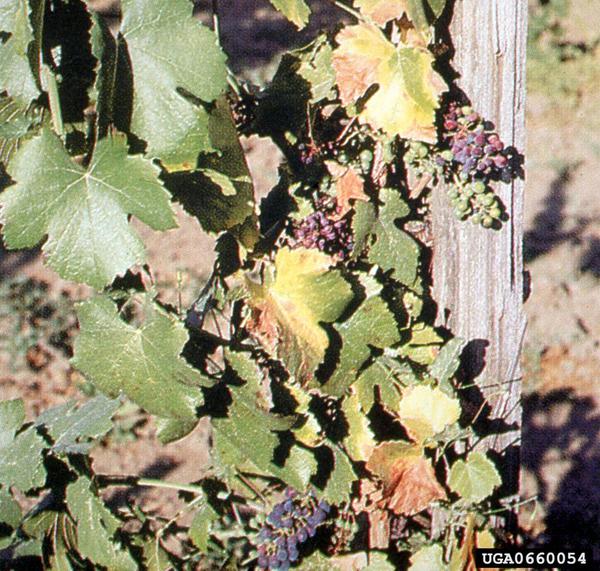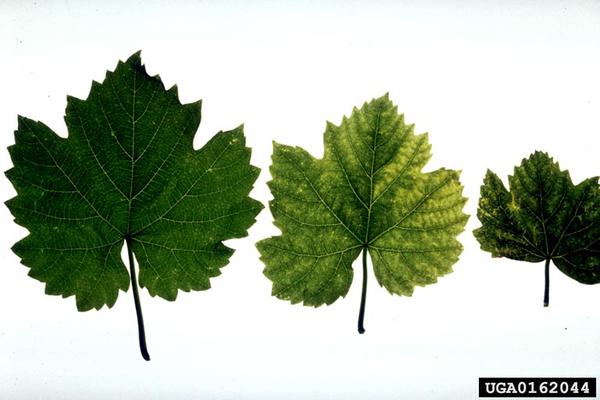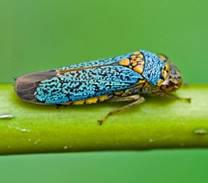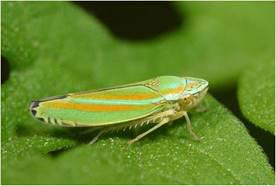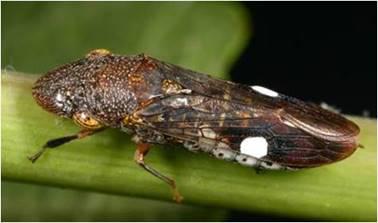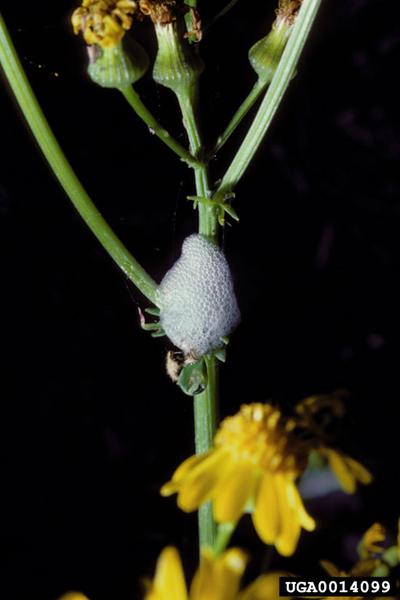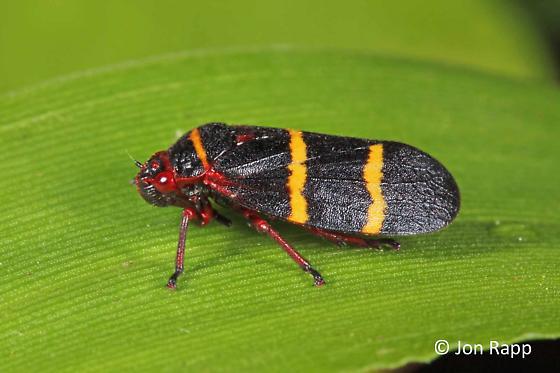Disease Biology in North Carolina
Pierce’s Disease is one of the most serious diseases affecting grapes in North Carolina. This disease is caused by the bacteria, Xylella fastidiosa, and spread by several species of sucking insects. Insect vectors for the disease include several species of sharpshooters and leafhoppers (see Vector Biology in North Carolina). All of these insects feed by piercing and sucking nutrients from plants. When they feed on an infected plant and then move to feed on a healthy plant, they can move the bacteria and spread the disease. More than 90 species of woody plants, including common shade trees, can harbor the bacteria and be a potential source of disease in the vineyard.
Damage in North Carolina Grapes
When a plant is infected with Pierce’s Disease, the bacteria stay, at first, in a localized area. In these localized infections, bacteria reproduce in the vascular tissue of the plant, reducing the flow of water through that area. This damage is why Pierce’s Disease infected vines exhibit similar symptoms to water-stressed plants. Localized infections that occur late in the season are often temporary, do not affect the growth of the whole vine, and have little impact on yield.
Systemic infections occur when a localized infection spreads throughout an entire plant. Systemic infections reoccur from year to year, reduce vine vigor and yield, and eventually kill infected vines. Risk of systemic infection is highest when Pierce’s Disease is spread to a plant early in the season. In North Carolina, infections that occur in April or May are most likely to become systemic infections. After that, risk dramatically decreases.
Four key symptoms appear in late summer associated with Pierce’s Disease in grapes:
- Outer edges of the leaves will turn red or yellow, followed by concentric rings of leaf browning. This makes the leaves look “scorched.”
- In the fall, leaves will fall, but the petiole will remain attached to the vine.
- Fruit frequently becomes shrunken and raisin-like upon the vines.
- Bark will age unevenly, leading to patches of green bark surrounded by brown bark.
In the spring, leaves on vines that have systemic infections of Pierce’s Disease can have yellowing between the veins.
Plants with the symptoms listed above should be marked and observed or tested for bacteria again the following mid to late summer in order to determine if infections are systemic. Only systemic infections are a concern for management.
Risk Factors for NC Vineyards
Mucadine grapes have a high degree of tolerance to Pierce’s Disease. They may harbor the infecting bacteria without exhibiting symptoms. As such, muscadine grapes are considered low risk. European grapes (V. vinifera) and some European / American hybrids are more susceptible and should be managed to prevent disease in high-risk areas of North Carolina.
The University of California reports that “recovery is higher in Chenin blanc, Sylvaner, Ruby Cabernet, and White Riesling, compared to Barbera, Chardonnay, Mission, Fiesta, and Pinot noir. Thompson Seedless, Cabernet Sauvignon, Gray Riesling, Merlot, Napa Gamay, Petite Sirah, and Sauvignon Blanc are intermediate in their susceptibility to this disease and in their probability of recovery. In tolerant cultivars the bacteria spread more slowly within the plant than in more susceptible cultivars.”
Risk of systemic infection in plants decreases in areas with low winter temperatures. Places that experience five or more days of temperatures below 15°F are at lower risk for developing systemic infections. In North Carolina, the mountains are considered lower risk, and the Piedmont and Coastal Plain considered high risk.
In high risk areas, systemic infections are more likely to occur from insect-feeding early in the season. A study of infection timing showed that only 54% of plants recovered from infections that occurred in April and May, but 88% of plants recovered from infections that occurred in June or later.
Vector Biology in North Carolina
Although several insect species can spread Pierce’s Disease in grapes, these vector insects occur with different frequencies and differ in their ability to transmit the bacteria. In North Carolina, insect vectors that have population peaks in early spring are the ones that should be the focus of management efforts, because infections spread by these insects have the greatest potential to become systemic in grapes. Insects that are abundant later in the summer or fall are of little concern, because the disease spread by them is likely to be minor and not result in systemic infection. The most important insect vectors in North Carolina are broad-headed sharpshooters, Graphocephala spp. leafhoppers, and bespeckled leafhoppers.
Broad-headed Sharpshooter
The broad-headed sharpshooter (Oncometopia orbona) has a high degree of efficiency in spreading Pierce’s Disease. In the most recent work on transmission in North Carolina, broad-headed sharpshooters had a 69% transmission efficiency. However, broad-headed sharpshooters are less common than other insect vectors in North Carolina. Broad-headed sharpshooter populations usually peak in May to early June.
Graphocephala Versuta
Graphocephala versuta is the most abundant insect vector of Pierce’s Disease in North Carolina. G. versuta is not very efficient in spreading Pierce’s Disease. In recent work on transmission in North Carolina, G. versuta had a transmission efficiency of just 5%. However, G. versuta makes up for efficiency in sheer numbers, with often 10 to 100 times more of this species occurring in North Carolina vineyards than other potential vectors. As such, G. versuta probably has similar importance to broad-headed sharpshooters for disease transmission. G. versuta populations usually build throughout May and June and peak in July.
Bespeckled Leafhopper
The bespeckled leafhopper (Paraphlepsius irroratus) is likely one of the top three insect vectors in North Carolina. It has moderately high abundance, more than the broad-headed sharpshooter, but less than G. versuta. and has been shown to transport the bacteria that causes Pierce’s Disease, but its disease transmission efficiency is poorly documented. Bespeckled leafhopper populations usually peak in May.
Glassy-winged Sharpshooters
The glassy-winged sharpshooter (Homalodisca coagulata) is one of the most important vectors of Pierce’s Disease in other parts of the United States. However, glassy-winged sharpshooters are not found in many of the counties where susceptible grapes are grown in North Carolina, and even where it is found, it is present in very low numbers.
Spittlebugs
Spittlebugs are often seen feeding on grasses or trees near grape fields. The immature insects surround themselves with a distinctive protective coating of bubbles that looks like a glob of spit stuck on a plant. Adults look similar to leafhoppers or sharpshooters. Spittlebugs can potentially vector Pierce’s Disease, as they sometimes are found with the bacteria in their bodies, but spittlebugs have not been shown to transmit the disease in North Carolina. Due to their low mobility, they likely are not a major contributor to disease spread.
Sampling and Thresholds
No economic thresholds exist for Pierce’s Disease, and generally a preventative approach is taken protect vines in high risk areas during the time they are most susceptible to disease. Once leaves begin growing in the spring, growers in high-risk areas should monitor for insect vectors using yellow sticky traps to know when to apply foliar insecticides. Vineyards in the North Carolina Piedmont and Coastal regions are considered to be high risk due to higher winter temperatures. The traps should be checked weekly for the species listed above as vectors and other leafhoppers. Counted insects can be removed and the traps can be reused for several weeks, as long as they remain sticky. The NC Plant Disease and Insect clinic can help with insect identification from photographs.
Management Options
Cultural Control
Variety selection can reduce risk of Pierce’s Disease. European (V. vinefera) grape varieties are highly susceptible to Pierce’s Disease, while muscadines, fox (V. lubrusca) grapes, and vinifera x lubrusca hybrids have low susceptibility.
Removing infected vines can reduce disease transmission within a vineyard.
Conventional Insecticides
Refer to the North Carolina Agricultural Chemicals Manual for the most current recommendations on materials for Pierce’s Disease vector suppression. Pesticide toxicity information for honeybees is also available in the North Carolina Agricultural Chemicals Manual.
Several systemic neonicotinoid pesticides are available for reducing insect transmission of Pierce’s Disease. These materials work largely by deterring insect feeding. Soil applied insecticides should be applied at budbreak in high risk areas. As these materials will be best taken up by the vines if applied in a large volume water, application through the drip irrigation system is recommended.
Alternately or in conjunction with soil applications, a foliar application of these materials can be applied timed to spring increases in vector counts. In North Carolina, these applications typically take place in April or early May. These materials can become partially systemic through foliar applications, but not to the same degree as from soil applications.
For any insecticide application, protecting the vines when they are vulnerable early in the season is key to reducing disease incidence. Early-season transmission of disease result in much higher systemic infections in the plants than infections that occur in June or later.
Organic Insecticides
Organic stylet oils are organically-acceptable insecticides that have some efficacy against Pierce’s Disease insect vectors. They should be applied in the spring when monitoring reveals a rise in insect vector numbers and may need to be applied frequently in order achieve acceptable suppression. Multiple applications may be necessary to protect plants.
Kaolin clay (Surround WP) also provides suppression of Pierce’s Disease transmission. This material must be applied at a high enough volume to coat plants thoroughly.
Publication date: May 21, 2020
Recommendations for the use of agricultural chemicals are included in this publication as a convenience to the reader. The use of brand names and any mention or listing of commercial products or services in this publication does not imply endorsement by NC State University or N.C. A&T State University nor discrimination against similar products or services not mentioned. Individuals who use agricultural chemicals are responsible for ensuring that the intended use complies with current regulations and conforms to the product label. Be sure to obtain current information about usage regulations and examine a current product label before applying any chemical. For assistance, contact your local N.C. Cooperative Extension county center.
N.C. Cooperative Extension prohibits discrimination and harassment regardless of age, color, disability, family and marital status, gender identity, national origin, political beliefs, race, religion, sex (including pregnancy), sexual orientation and veteran status.

